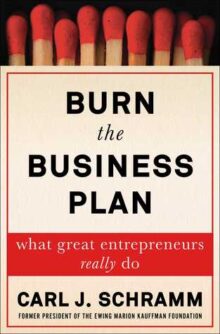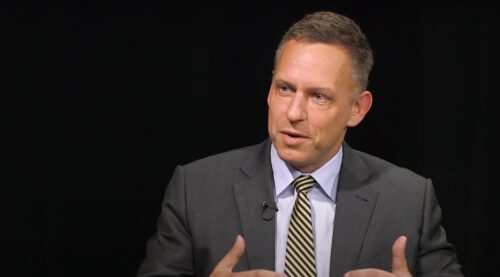The Syracuse University professor and former Kauffman Foundation president talks about business plans and entrepreneurship, including philanthropic efforts to support it, with Michael E. Hartmann.
Carl Schramm is a leading international authority on innovation, entrepreneurship, and economic growth. He has been a University Professor at Syracuse University in Syracuse, N.Y., since leaving Kansas City’s Ewing Marion Kauffman Foundation as its president in 2012. The $2 billion Kauffman Foundation, which he joined in 2002, is the world’s largest philanthropy dedicated to promoting entrepreneurship.
After earning his Ph.D. in economics from the University of Wisconsin in 1968, Schramm began teaching at Johns Hopkins University, where he started the nation’s first research center on health-care finance. He later earned a law degree from Georgetown.
Dubbed by The Economist and widely considered by others an “evangelist for entrepreneurship,” Schramm has founded or co-founded five companies. He has also served in executive-level positions at several major corporations.
A prolific author of books and articles, in both the academic and popular press, Schramm’s most-recent of many books is Burn the Business Plan: What Great Entrepreneurs Really Do. In 2010, he introduced the concept of “expeditionary economics,” an emerging field of study focusing on the rebuilding and reconstruction of economies in post-conflict and disaster-struck nations. He is a trustee of the Templeton World Charity Foundation, as well.
Below is the first of two parts of an edited transcript of a discussion that Schramm was kind enough to have with me in July. The second part, in which he talks about entrepreneurship, education, and philanthropy, is here.
Hartmann: Where were you born, and where did you first go to school?
Schramm: I was born in Syracuse, N.Y., and went to school there all the way up to my undergraduate degree from Le Moyne College, which is the local Jesuit school. Then, I went to the University of Wisconsin for my Ph.D. Then, when I began teaching, I went to law school at night in Washington, D.C., at Georgetown.
Hartmann: You had a Ford Foundation fellowship for your time at the University of Wisconsin, right? Those are some serious progressive credentials in America. Was Ford’s investment worth it?
Schramm: There was really no ideological overlay at all. Back in the 1970s, there was thought to be a severe shortage of college professors. Ford was funding fellowships at universities, including Wisconsin, Berkeley, and the University of Chicago, that ranked highly in ranked in terms of their production of professors.
It is true that, at Wisconsin, they would claim to be the home of the entire progressive tradition. There was the “Wisconsin Idea,” the notion of faculty experts shaping public policy for the state government. Social Security was fundamentally birthed out of there, as was the outline of much labor-relations law in the country, including workers’ compensation. It had a rich tradition in terms of its sympathy for labor. John R. Commons, one of the founders of the American Economic Association, developed the thesis of institutional economics, which saw unions as an important force that disturbed free-market theory. In fact, I went to Wisconsin because it had the strongest program in labor economics.
It followed the German model of higher education, as did Johns Hopkins, where I took my first faculty job. Hopkins was really the most-influential of all American universities in terms of what we think of as a research institution. Its first faculty was largely trained in Germany. It began as a research institute. It was the first American university to grant the Ph.D. degree. Harvard and many other schools refashioned their institutions on Hopkins.
Hartmann: And what did you do when you got to Johns Hopkins?
Schramm: I showed up there because there were studies just getting underway to look at the labor-force implications of various diseases. The first book I ever wrote was about the implications of alcoholism on labor-force composition. Shortly, however, I became interested in the economics of health care. There were maybe five or 10 economists thinking about the problem—every one of us had a degree in labor economics. We were all interested in trying to understand institutions—non-market institutions such as were once referred to as charitable or voluntary hospitals and nonprofit insurance companies, which is how Blue Cross and Blue Shield were formed.
Hartmann: And how did you end up as an insurance executive in Milwaukee?
Schramm: While at Johns Hopkins, I created a company, actually by accident. Doing research on hospital accounting data, I stumbled on an insight that would prove valuable to managing hospitals. With some students, I started a company that did comparisons of hospital efficiency. The company got bought by an insurance company. I had by then left the university—Hopkins had an allergy to professors who turned out to be entrepreneurs. Next thing I knew, I had been recruited to be president of the Health Insurance Association of America in D.C. Next, I was recruited to be executive vice president of Portus, a Dutch holding company, which ran its health-insurance operations from Milwaukee. It was called the Time Insurance Company [now Assurant]. It was a terrific company, just a great place to work.
Hartmann: How did Milwaukee and its economy strike you?
Schramm: I had a particular view on Milwaukee because Fortis was in was the second-largest private employer in the city. There was no doubt about it, Milwaukee was struggling at the time. A number of the big companies had been sold, so the city was no longer the capital of beer-making, small-engine production, or electrical switching equipment. The biggest, healthiest company there was Northwestern Mutual. I like the vibe in Milwaukee and count my years there as helping shape my curiosity about cities.
Entrepreneurship, and its unfortunately broadening definition
Hartmann: You’re associated with the topic of entrepreneurship. What about it right now in America? How’s it been doing?
Schramm: I think I do have a particular window on it. By accident in my career, I became president of the Kauffman Foundation, which had two billion dollars and it's supposed to be devoted to entrepreneurship and educational reform. In the former case, its focal geography is America and in the latter, Kansas City.
Entrepreneurship was an area very poorly attended by economists. There was almost no data. We didn’t even know how many new companies were being started in the United States. It’s still almost impossible to get a real fix on entrepreneurship and how it’s doing.
One of the reasons is that the term itself came to describe almost anything. You see a pastor in a church being described as entrepreneurial, you see a professor of classics being described as entrepreneurial. Many accounting firms describe themselves as entrepreneurial, which almost seems unethical. You don't want entrepreneurial accountants.
Today, everything and everybody is “entrepreneurial.” Universities are encouraging “entrepreneurialism” in the business schools. The number of students who want to start new companies doesn’t seem to be as high as the number that want to start new nonprofits, many to become NGOs, non-governmental agencies. They call themselves social entrepreneurs.
The definition of entrepreneurship has been—well, the right word is prostituted. It’s a word being applied blindly by people who have no history with or understanding of it.
I’d say about 6,000 people make their daily living teaching or coaching aspiring entrepreneurs. Well over half of those people never worked in a start-up. I’m such a firm believer in the importance of entrepreneurs that I think we shouldn’t be having amateurs and snake-oil salesman dealing with the subject.
There’s an entire apparatus in place to teach entrepreneurship as a college-level major. But, remarkably and causing apparently no difficulty for the faculty involved, there really is no canon of empirically based knowledge on which to base a curriculum! For example, the statistical reality is that the average age of an entrepreneur starting his or her business is 39 years old. That’s usually a long, long time away from graduating from college, and there's no evidence that college training entrepreneurs makes them any more successful. In fact, more than half of entrepreneurs do not have college degrees.
Hartmann: If I were to ask you whether entrepreneurships is doing better in some places around the globe than others, I guess the same challenges would be there? There’d be little evidence on which to base a conclusion about that?
Schramm: Your question points to a terrible shortcoming of academics. A goodly number spend time trying to measure the relative entrepreneurial nature of one economy or one population compared to another. The data they use, however, is terrifically fragile in many countries. Many nations don’t count startups. And, for the most part, those that do don’t do it consistently.
But that doesn’t stop a whole slew of intellectual entrepreneurs. The cadre of professors who purport to know what makes once country more entrepreneurial than another, using very sketchy data, are also ready to work as consultants to governments around the world to improve the culture of entrepreneurship in their country. Of course, this inevitably, and not surprisingly, results in higher comparative rankings for the client countries.
Hartmann: Your most-recent book is Burn the Business Plan. Don’t I have to have a plan to be a successful entrepreneur?
Schramm: No. Just check the inventory of entrepreneurs we think of as emblematic of the type. Steve Jobs never had a business plan. Bill Gates never had a business plan. Uber and Facebook were created without business plan. Same with Google. Companies such as Intel and Oracle—you can't find a business plan. They didn’t write them.
And importantly, there were never business plans for AT&T, GE, Johnson & Johnson, Ford, or General Motors, Carrier, or Metropolitan Life. Their founders were experimenting with the market, trying to figure out if what they were doing had a commercial purpose. It was really sort of messing around to see if what they had was better than what was on the market. Could they leverage technology and make a new or better or cheaper tool or machine or communications system or insurance policy and would people pay for it?
Hartmann: They were tinkerers.
Schramm: Yep. My book basically says many, if not most, entrepreneurs are overtaken by an idea that becomes a business model mostly by accident. They were, as you say, tinkering and their tinkering solved the problem. They were surprised that they could do it, and suddenly they understood there were other people whom they could help. So, yeah, it’s tinkering.
So is there a “typical entrepreneur”? If so, if I can’t have a business plan, can I have an individual plan to be an entrepreneur? No, I don’t think that’s true. People say “I'm a serial entrepreneur.” Lots of social stimuli encourage people to crow like that, but many very successful entrepreneurs would say, “Look, it was an accident.”
I mean, it’s very much my own career. I was a professor a professor at Johns Hopkins. I’m on my way to becoming a tenured full professor—the top of the mountain for an academic. I don’t want to start a business. It snuck up on me, and this is, as mentioned, very typical. In fact, in my book, that’s basically the narrative of how people become entrepreneurs, for the most part. They are overtaken by an idea and they are totally surprised that what they’ve invented. What they’ve created is right there in front of them, and then they basically understand that they could help other people.
So, it’s some admixture of surprising inventiveness and then they’re urged to reaffirm what they did, and the only way you do that in the market is where people say, “Yes! I’ll pay for this. What you are selling helps me save time. You’ve changed the value of time in my life. It’s made something I have to do much more convenient, easier. I can do it faster and cheaper.”
Hartmann: What can philanthropy do to foster entrepreneurship? What’s worked?
Schramm: That’s a very complicated question, with a complicated answer. It’s not clear. I’ll tell you from my own history of watching philanthropists try to promote entrepreneurship that they’ve created much more mischief advancing what they see as intuitive narratives, largely drawn from their own experiences, that just do not reflect reality. Unfortunately, they buy into the “received wisdom” of entrepreneurship, which is really more social convention than a reflection of reality.
We’ve we have a long history as human beings of creating narratives about things that just aren’t true. I’m thinking about the days when I was in graduate school when we were absolutely certain because of global population growth and the perceived limited supply of food that within five years, there would be huge global unrest, really war, and it would start in India, the nation with the most-acute food shortage. Well, five years later, India was a net exporter of food. Like so many “crises” that fixate our public discourse, a reading of “point” data led to a worldwide panic about food shortages.
We see much the same going on today in the fevered language about the impact of pollution on global warming and rising sea levels. Curiously, looking at prices for waterfront buildings in Miami, Seattle, New York and San Diego, there doesn’t seem to be evidence that individuals buying real estate really think the predicted catastrophes are likely to happen anytime soon.
Foundations have mostly gotten into entrepreneurship in an attempt to help poorer populations internationally or domestically, usually by inducing “bright kids” to go do nice things—totally ignoring the reality of 39-year-olds being the folks who start most businesses.
Foundations think they’re doing entrepreneurship, but they’re more likely expanding the world of nonprofits. As I’ve mentioned, in many universities, “social entrepreneurs” who want to start NGOs outnumber “real,” by which I mean profit-seeking, entrepreneurs. One of the tests of a successful new business is whether it’s going to grow fast. Nonprofits, for the most part, don’t know what scale growth is.
The conversation continues in Part 2 of 2 of here.







